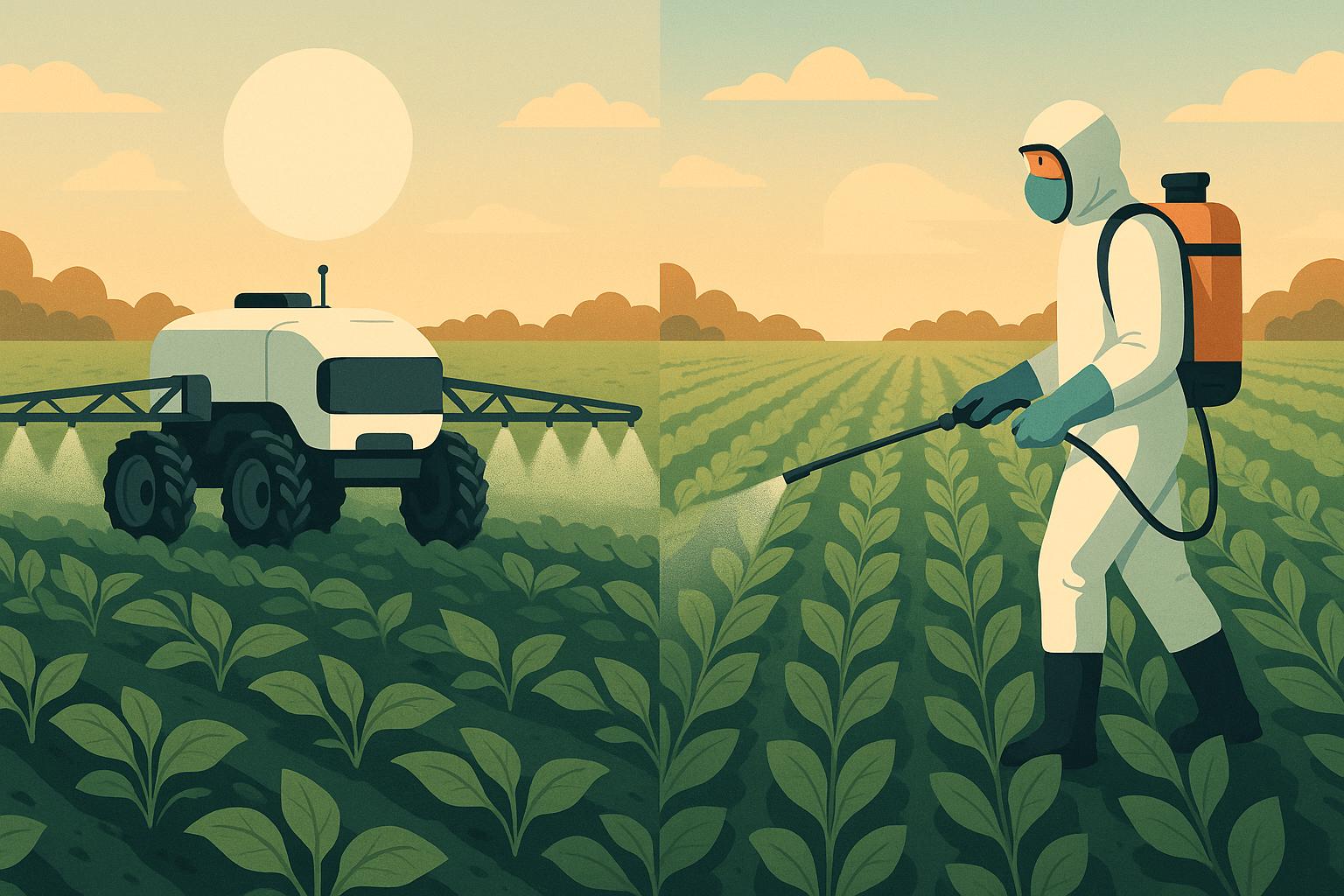In today’s agricultural landscape, growers face increasing pressure to produce higher yields with fewer resources—all while preserving the environment and meeting consumer demand for sustainable practices. One of the most significant developments in modern agriculture is the integration of precision farming techniques with fungicide applications. This combination enables smarter, more efficient crop health management by targeting disease threats with remarkable accuracy.
Fungicide-assisted precision farming is no more a sci-fi fantasy; rather, it is a realistic, data-driven strategy that is changing how farmers anticipate, identify, and address fungal threats. The basis for this change is examined in this essay, which also emphasizes how disease control is being revolutionized by digital tools, real-time data, and improved inputs.
The Role of Fungicides in Modern Agriculture
An estimated 15% to 20% of crop losses worldwide occur annually due to fungal diseases, some of which can destroy entire fields within a matter of days. Historically, the primary line of defense has been fungicides, which shield plants from diseases such as powdery mildew, rusts, blights, and root rots.
However, spraying a field all at once can result in overuse, increased input costs, and pathogen resistance. Consequently, the use of fungicides has evolved towards focused, scientifically supported methods that complement the principles of precision farming.
Although modern fungicides are more efficient and environmentally friendly, their full potential is only achieved when used in conjunction with data-supported timing, dose, and placement.
How Precision Farming Enhances Fungicide Application
Precision agriculture refers to the use of GPS, sensors, satellite imagery, and machine learning to make real-time, site-specific decisions on the farm. In the context of fungicide application, it ensures that fungicides are applied only where needed, reducing waste and improving efficacy.
- 🤖 Innovative sprayers are no longer just mechanical tools—they’re smart machines. Armed with advanced sensors, they can detect infected plants in real-time and automatically adjust application rates with pinpoint accuracy. It’s like giving your crops a personalized treatment plan, on the move.
- 🛰️🌱 High above, satellite imagery and NDVI mapping act as the crop’s early warning system. By analyzing subtle changes in vegetation health, these tools can spot signs of stress before your eyes can—saving you time, money, and potentially, your entire harvest.
These technologies offer a higher degree of control, especially in fields with variable soil types, moisture levels, or crop susceptibility. Precision tools not only preserve the efficacy of fungicides but also lower costs by minimising unnecessary treatment areas.
To support an integrated pest and disease management strategy, some farms also incorporate other natural pest solutions. For example, many producers find it helpful to buy Pyrethrin Insecticide to complement fungicide use in a holistic crop protection plan. When applied with the same level of data-backed precision, such natural products can enhance yield protection while maintaining ecological balance.
More intelligent Disease Prediction with AI and Sensors
Predictive modeling is one of the most significant innovations in precision fungicide application. Farms can now predict disease outbreaks using artificial intelligence by combining data inputs, including temperature, humidity, soil moisture, and past disease trends.
Cloud-based technologies use real-time data from field sensors to assess risk levels in various zones. The device can notify the farmer or even activate automatic spraying systems if it detects conditions conducive to fungus growth, such as excessive humidity and leaf wetness.
The need for curative intervention, which can sometimes be more costly and ineffective, is significantly reduced by this preventive paradigm. This technique also reduces crop exposure to chemical inputs, thereby protecting plant health and customer confidence.
🚜💡 In 2025, the Global Agricultural AI Network dropped a stat that should make every grower pause:
Farms using AI to predict crop diseases slashed their fungicide use by 31%.
Integrating Biologicals and Soil Microbiome Health
Fungicides don’t work in isolation. Their performance is closely tied to the overall health of the plant and the biological integrity of the soil. In precision systems, more farmers are combining chemical fungicides with biological fungicides or biostimulants to achieve a synergistic effect.
To boost the plant’s immunological response, biologicals such as Bacillus subtilis and Trichoderma spp. are employed to colonise the root zone and suppress infections. This dual strategy develops a concept of illness control that is proactive rather than reactive.
Additionally, robust soil microbiomes help plants develop systemic resistance, which reduces their susceptibility to infection. These days, fungicide regimes are being customised to support these live ecosystems rather than interfere with them using instruments that monitor soil biodiversity and microbial activity.
“🌍🌾 If we want to feed the world sustainably, we must stop treating our fields like battlegrounds ⚔️ and start treating them like ecosystems 🌱🦋.”
As this quote highlights, the shift in mindset is just as significant as the shift in methods. Farmers adopting precision fungicide strategies are not simply trying to eliminate disease—they are striving to maintain harmony between productivity and natural processes.
The Economics of Targeted Fungicide Application
One common misconception is that precision tools are costly and impractical for small or medium-sized farms. However, the return on investment tells a different story.
🧠 Insightful & Confident:
According to the Precision Ag Institute, targeted fungicide sprays in 2024 didn’t just control disease—they boosted profits. Farms saved an average of $22 per acre, thanks to sharper crop quality and leaner input costs.
Additionally, precision systems often enhance marketability, particularly for crops targeted at high-end markets with stringent low-chemical-residue specifications. Consumers and buyers are increasingly interested in goods produced using traceable, sustainable methods.
By automating numerous repetitive operations, precision fungicide treatment also lowers labour costs by freeing up personnel to concentrate on value-added tasks, such as post-harvest handling or soil management.
Connected Devices and Farm Management Software
These days, digital platforms act as command centres for decisions about crop health. Dashboards that include real-time disease alerts, soil data, fungicide schedules, and weather forecasts are available to farmers. Based on past crop cycles and results, certain systems even provide adaptive recommendations.
By enhancing absorption and decreasing drift, this integrated decision-making process ensures that fungicides are applied not only when necessary but also under the most favorable circumstances.
Tools such as Climate FieldView and xarvio Field Manager, for instance, offer disease modelling based on historical datasets and exact field locations. These instruments are highly accessible because they are compatible with a wide range of spraying equipment.
Cross-Compliance and Sustainability Metrics
Compliance is increasingly linked to sustainability criteria as international agricultural legislation evolves. Using fungicides precisely is essential to achieving these goals.
Farmers are being urged to demonstrate their environmental responsibilities through programmes like USDA’s climate-smart programs and Europe’s Farm to Fork policy. Predictive models, input logs, and field maps provide verifiable information that meets these criteria and gets financing or certification.
More information about aligning with sustainable practices can be found through the FAO’s Integrated Pest Management framework, which promotes balanced pest control in both conventional and organic systems.
Addressing Resistance Management
A significant threat to the long-term efficacy of fungicides is pathogen resistance. Resistance in fungal strains can arise from the overuse or abuse of fungicides, particularly those with a specific mode of action.
Precision agriculture provides a systematic method for managing resistance. Through zone-specific application and a rotation of modes of action based on predicted insights, farmers can disrupt fungal adaptation cycles.
Additionally, by ensuring that fungicides are employed as part of a multi-layered approach, this data-driven model reduces the strain on any single product or strategy.
Frequently Asked Questions
- Can small farms affordably adopt precision fungicide systems?
Yes, many entry-level precision tools are scalable and budget-friendly. Mobile apps, drone services, and cooperative data-sharing platforms are making this technology more accessible. - Do fungicides harm soil microbes if applied precisely?
When used according to guidelines and in conjunction with soil health strategies, fungicides can be applied with minimal impact on beneficial microbes. Precision ensures localized treatment, avoiding overuse. - Is weather data really that critical for fungicide use?
Absolutely. Temperature, humidity, and leaf wetness are key factors in the development of fungal diseases. Using weather data to schedule applications significantly increases efficacy. - Are biological fungicides as effective as chemical ones?
Biologicals may work more slowly but are highly effective when integrated with other methods. Their real strength lies in prevention and supporting plant immunity.
A Smarter Path to Plant Health
Fungicide-assisted precision farming is an intriguing fusion of technology and tradition. It provides farmers with the tools they need to enhance their tried-and-true techniques with improved data, better timing, and better outcomes, rather than asking them to abandon them.
With this approach, crop protection is reframed as a proactive rather than reactive activity. It satisfies the rising demand for sustainable production, respects soil biology, and lessens dependency on pesticides without sacrificing productivity.
This framework provides a unique, well-rounded solution as agriculture develops further. a more intelligent strategy that respects the art of stewardship as well as the science of plant pathology.
One application at a time, farmers that follow this route are not only protecting their crops but also influencing a more sustainable future.



